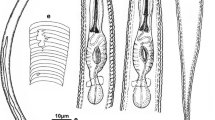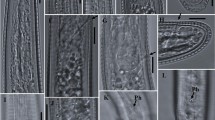Abstract
A new plant nematode species named Paratylenchus guangzhouensis n. sp. was extracted from the soil associated with Bambusa multiplex in Guangzhou, Guangdong Province, China. The new species is characterized by having the female with a small body 217–247 μm long, a slender stylet 43–49.5 μm long, head rounded without distinct submedian lobes, amphid openings large, and bow-tie like in shape, oral opening with two prominent ridges laterally, lateral field with three distinct lines, small lateral vulval flaps and tail tip finely rounded to bluntly rounded; male with a 237.5 μm long body, spicules 15.5 μm long, stylet lacking and pharynx degenerate; and the fourth-stage juvenile with a stylet. The internal transcribed spacer sequences of ribosomal RNA (ITS rRNA) gene of the new species were amplified and sequenced, and a phylogenetic tree inferred from the ITS rRNA gene is given in this study.




Similar content being viewed by others
References
Andrássy, I. (1985). Paratylenchus microdorus. CIH descriptions of plant-parasitic nematodes. Set 8, No. 107. Farnham Royal, UK: Commonwealth Agricultural Bureaux.
Brzeski, M. W. (1976). Paratylenchus bukowinensis. CIH descriptions of plant-parasitic nematodes. Set 6, No. 79. Farnham Royal, UK: Commonwealth Agricultural Bureaux.
Brzeski, M. W. (1995). Paratylenchinae: morphology of some known species and descriptions of gracilacus bilineata sp. n. and G. vera sp. n. (nematoda: tylenchulidae). Nematologica, 41(4), 535–565.
Brzeski, M. W. (1998). Nematodes of Tylenchina in Poland and temperate Europe. Warszawa, Poland: Muzeum i Instytut Zoologii Polska Akademia Nauk.
Brzeski, M. W., & Háněl, L. (2000). Paratylenchinae: evaluation of diagnostic morpho-biometrical characters of females in the genus paratylenchus micoletzky, 1922 (nematoda: tylenchulidae). Nematology, 2(3), 253–261.
Chen, D. Y., Ni, H. F., Tsay, T. T., & Yen, J. H. (2008). Identification of gracilacus bilineata and G. aculenta (nematoda: criconematoidea, tylenchulidae) among bamboo plantations in Taiwan. Plant Pathology Bulletin, 17(3), 209–220.
Doucet, M. E. (1994). New data on gracilacus colina Huang & Raski, 1986 (nemata: criconematoidea). Fundamental and Applied Nematology, 17(2), 117–121.
Geraert, E. (1965). The genus. Paratylenchus. Nematologica, 11(3), 301–334.
Ghaderi, R., Kashi, L., & Karegar, A. (2014). Contribution to the study of the genus paratylenchus micoletzky, 1922 sensu lato (nematoda: tylenchulidae). Zootaxa, 3841(2), 151–187.
Hooper, D. J., Hallmann, J., & Subbotin, S. A. (2005). Methods for extraction, processing and detection of plant and soil nematodes. In M. Luc, R. A. Sikora, & J. Bridge (Eds.), Plant parasitic nematodes in subtropical and tropical agriculture (2nd ed., pp. 53–86). Wallingford: CABI Publishing.
Huang, C. S., & Raski, D. J. (1986). Four new species of gracilacus Raski, 1962 (criconematoidea: nemata). Revue de Nématologie, 9(4), 347–356.
Huelsenbeck, J. P., & Ronquist, F. (2001). Mrbayes: Bayesian inference of phylogenetic trees. Bioinformatics, 17(8), 754–755.
MacDonald, D. H. (1976). Effects of paratylenchus hamatus on productivity of greenhouse roses. Journal of Nematology, 8(4), 294.
Mohilal, N., & Dhanachand, C. (2004). Two new species of paratylenchidae from Manipur. Uttar Pradesh Journal of Zoology, 24(2), 173–177.
Nylander, J. A. A. (2004). MrModeltest 2.3, Program distributed by the author. Evolutionary Biology Centre: Uppsala University, Uppsala, Sweden.
Raski, D. J. (1962). Paratylenchidae n. fam. with descriptions of five new species of Gracilacus n. g. and an emendation of Cacopaurus Thorne, 1943, Paratylenchus micoletzky, 1922 and criconematidae Thorne, 1943. Proceedings of the Helminthological Society of Washington, 29(2), 189–207.
Raski, D. J. (1975). Revision of the genus paratylenchus micoletzky, 1922, and descriptions of new species. Part II. Journal of Nematology, 7(3), 274–295.
Raski, D. J. (1976). Revision of the genus paratylenchus micoletzky, 1922 and descriptions of new species. Part III of Three parts. Journal of Nematology, 8(2), 97–115.
Seinhorst, J. W. (1959). A rapid method for the transfer of nematodes from fixative to anhydrous glycerin. Nematologica, 4(1), 67–69.
Shahina, F., & Maqbool, M. A. (1993). Gracilacus musae n. sp., (nematoda: paratylenchinae) from banana field in Sindh, Pakistan. Pakistan Journal of Nematology, 11(1), 1–5.
Siddiqi, M. R. (1986). Tylenchida parasites of plants and insects. Slough, UK: Commonwealth Institute of Parasitology.
Siddiqi, M. R. (2000). Tylenchida parasites of plants and insects (2nd ed., ). Wallingford, UK: CABI Publishing.
Siddiqi, M. R., & Goodey, J. B. (1964). The status of the genera and subfamilies of the criconematidae (nematoda); with a comment on the position of. Fergusobia. Nematologica, 9(3), 363–377.
Tamura, K., Peterson, D., Peterson, N., Stecher, G., Nei, M., & Kumar, S. (2011). MEGA5: molecular evolutionary genetics analysis using maximum likelihood, evolutionary distance, and maximum parsimony methods. Molecular Biology and Evolution, 28(10), 2731–2739.
Van den Berg, E., Tiedt, L. R., & Subbotin, S. A. (2014). Morphological and molecular characterisation of several paratylenchus micoletzky, 1922 (tylenchida: paratylenchidae) species from South Africa and USA, together with some taxonomic notes. Nematology, 16(3), 323–358.
Vrain, T. C., Wakarchuk, D. A., Levesque, A. C., & Hamilton, R. I. (1992). Intraspecific rDNA restriction fragment length polymorphism in the xiphinema americanum group. Fundamental and Applied Nematology, 15(6), 563–573.
Wang, J. L., Zhang, J. C., & Gu, J. F. (2011). Method of extracting DNA from a single nematode. Plant Quarantine, 25, 32–35.
Wang, K., Xie, H., Li, Y., Xu, C. L., Yu, L., & Wang, D. W. (2013). Paratylenchus shenzhenensis n. sp. (nematoda: paratylenchinae) from the rhizosphere soil of anthurium andraeanum in China. Zootaxa, 3750(2), 167–175.
Acknowledgments
This work was supported by a Special Project of Scientific and Technological Basis of the Ministry of Science and Technology of the People’s Republic of China to Hui Xie (Grant number 2006FY120100).
Author information
Authors and Affiliations
Corresponding author
Rights and permissions
About this article
Cite this article
Wang, K., Li, Y., Xie, H. et al. Morphology and molecular analysis of Paratylenchus guangzhouensis n. sp. (Nematoda: Paratylenchinae) from the soil associated with Bambusa multiplex in China. Eur J Plant Pathol 145, 255–264 (2016). https://doi.org/10.1007/s10658-015-0836-z
Accepted:
Published:
Issue Date:
DOI: https://doi.org/10.1007/s10658-015-0836-z




